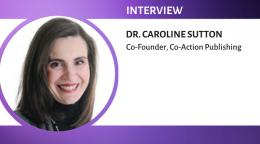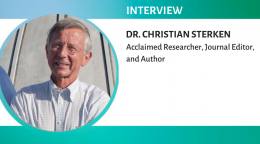Taking inclusion in peer review to a new level: Kids as reviewers for scientific manuscripts
Peer Review 2018
The theme for Peer Review Week 2018 is diversity in peer review and includes an interesting range of topics within its scope – inclusion of early career researchers in peer review, gender bias in peer review, geographical distribution of reviewers, etc. Here’s a series of posts dedicated to this year’s event and theme. Don’t forget to catch the special series of contributions from researchers and industry professionals on the theme of diversity.

This year, during Peer Review Week, we’re talking about diversity and inclusion in peer review, about getting a more diverse set of people to be part of the review process, about ensuring that peer reviews reflect the perspectives of different people. What better way to contribute to these discussions than showcasing a unique example of inclusivity in peer review!
We’re in conversation with Emma Clayton, Journal Manager of Frontiers for Young Minds, which is an open access journal supported by with a unique approach. What’s this approach, you ask? Involving kids and teens in the peer review of scientific articles. In this conversation, Emma tells us more about the Frontiers for Young Minds project and how the journal works with children to publish scientific findings that are not only accurate but also easily understood by lay audiences.
Emma has been with the Frontiers for Young Minds team since 2016. Following an MRes in Ecology and Environmental management, she decided to switch fields and move to enable scientific communication. In her current role, she strives to ensure that scientific discoveries reach young audiences and that scientists are able to successfully communicate their work to wider and younger audiences.
How did the concept for Frontiers for Young Minds come about?
Our Chief Editor, Prof. Robert Knight of UC Berkeley had the idea for a journal with an editorial board of kids, and he worked with Frontiers since 2013 to make it a reality.
For the benefit of our readers, could you tell us how Frontiers for Young Minds works with both scientists and children “to create articles that are both accurate and exciting”?
Frontiers for Young Minds aims to provide peer-reviewed science for younger audiences. Children and teens (ages 8-15) are our target audience, but they also act as the reviewers for the manuscripts, allowing them to play a crucial role in the scientific publishing process. We also have a board of Associate Editors and Chief Editors who help lead their sections and as scientists themselves, help to oversee the review process and the scientific quality of the journal. We currently have six specialty sections with Neuroscience being the first section we launched in 2013 and as we have grown over the years, we have expanded in subject areas launching, Astronomy, Mathematics, Earth and its Resources, Health and Biodiversity.
All young reviewers will work alongside a science mentor as a team, and the mentor is responsible for guiding the young reviewers through the articles, identifying any areas that were difficult to understand and collecting all their feedback. The feedback is then sent back to the authors for them to respond and revise their manuscript, ensuring that all concerns have been addressed. The paper will only be validated and published online once our young reviewers and mentor team are entirely satisfied with the revisions and that the paper is appropriate for a wider audience.
“The kids enjoyed reading it and providing feedback. The thought that they could help make the article better was very exciting to them--and something they don't often get to do in school. Overall a very fun and educational experience working with the kids.”
- A Frontiers for Young Minds mentor -
By involving young reviewers in the process, we empower them to think like scientists, ask questions and encourage them to become scientists themselves if that is the career they want to pursue. The journal creates reliable resources for the public, bridging a direct connection between scientists and the public. Research that would typically take several years to appear in textbooks can be accessed much sooner because of Frontiers for Young Minds.
There are no publication fees for authors to get involved nor is there a cost for getting involved on the editorial side or for using the articles. We often have teachers asking us for permission to use the articles but no permission is required and what’s more, anyone can read these articles and understand the latest discovery, not just younger audiences.
The idea of young readers providing inputs on research is fascinating. How do you go about selecting this group of reviewers? Do you provide them with any specific training?
Children and teens can sign up to be involved by contacting us (kids@frontiersin.org). They will need to identify a science mentor to work alongside with and once they are set up, the editorial office will invite them to a manuscript as soon as one becomes available.
We have a variety of materials prepared to help them get started in their new roles and it is also up to the mentor with their experience to help prepare them for this. We have explanations on the peer review process, guidelines on what they should be looking for when reviewing and a pre-prepared set of review questions to complete during the process.
“It is always fantastic to witness people’s reaction when they are first introduced to the journal.”
- Emma Clayton -
Based on the interactions you have had with scientists, how easy or difficult is it for them to break down scientific concepts in a way that makes it easy for young readers to understand?
It is a real challenge for them, but an extremely rewarding one! Many researchers are not sure where to start when writing their paper and that is why the journal is also a learning opportunity for them to become better communicators. There can be a concern among researchers that their findings will be misinterpreted by the media or the public if taken out of context, so allowing them to adapt their work themselves through Frontiers for Young Minds provides them with a channel to ensure that their findings are represented correctly.
How do you get mentors on board? Can interested researchers apply to be a mentor? Do they need to fulfill specific criteria?
Mentors will join the board with young reviewers as a team. Typically, mentors will be early career researchers with experience in the peer review process so that they can explain the process to their young reviewers. But we also have mentors that work as teachers or mentors with a lot of scientific outreach experience. Mentors should introduce the young reviewers to what life as a scientist is like, teach them critical thinking skills and explain to them the importance of the peer review process.
Interested researchers are more than welcome to contact us (kids@frontiersin.org) to apply either to become a mentor or as an Associate Editor, helping to oversee the review process.
What kind of responses has this initiative received thus far from the scholarly publishing community?
The response has been extremely positive with many wishing they knew about the journal sooner. It is always fantastic to witness people’s reaction when they are first introduced to the journal.
Based on your experience at Frontiers for Young Minds, what are some of the common mistakes researchers are prone to make when trying to simplify their research? And how could they avoid them?
One of the most common pitfalls is trying to explain as much as possible in a single article. Researchers are trained to describe things in a lot of detail so there is a tendency to explain everything in one article but instead they need to learn how to separate essential from non-essential. Researchers need to think outside of the box, change their style of writing and take this opportunity to be creative. Have fun with your writing and remember that elements of your paper like figures represent something entirely different to a younger audience so including the same figures found in your academic paper but in brighter colors or with larger fonts does not mean young readers will understand what they mean or find them compelling. Instead of using figures as a means to visualize data, think of them as a way to display meaning and solidify what it is that you have explained in the text.
At the end of the process, you’ll find that many researchers feel this renewed sense of motivation for their own work after having published with Frontiers for Young Minds.
How do you go about increasing the outreach of your publication, especially considering the fact that it is of great relevance to educators and schools?
We promote all our published articles on social media (Facebook & Twitter) and through our blog.
We also host live reviews inviting researchers to present their work to a panel of young reviewers, facing the challenge of having to answer many critical questions before hearing the final verdict of whether their paper will be accepted.
We attend as many relevant events as possible, for example, we attended the USA Science & Engineering Festival in April this year and this event attracts a huge number of people internationally – kids, parents, teachers and researchers.
A quick question about you: What made you switch from your work as an Ecologist to a career at an academic journal? Did you always want/plan to be part of the scholarly publishing space?
I knew that I wanted to stay connected with scientific research, but I didn’t necessarily want a career in academia. I believe that science and the latest discoveries found today should be made accessible and understandable to all so working with an open-access publisher and with Frontiers for Young Minds is a perfect fit for me.
The theme for Peer Review Week 2018 is diversity. Here’s my last question for you. What does diversity mean to you? How can journals become more inclusive?
To me, diversity means making sure that our Young Reviewers can be involved independent of background, gender, ethnicity or socio-economic status. We aim to promote international diversity by building partnerships with like-minded institutions around the globe and working with them to translate articles into new languages. You can inspire children of all backgrounds to pursue careers in research and that diversity will flow upwards into the scientific community as they grow older; working with projects like Frontiers for Young Minds to disseminate research is one way that journals can help achieve this.
Thanks, Emma! It was great talking to you!
Published on: Sep 09, 2018
Comments
You're looking to give wings to your academic career and publication journey. We like that!
Why don't we give you complete access! Create a free account and get unlimited access to all resources & a vibrant researcher community.





























